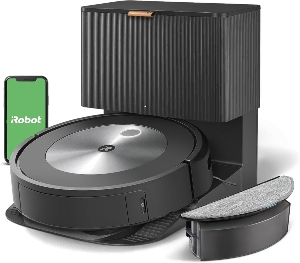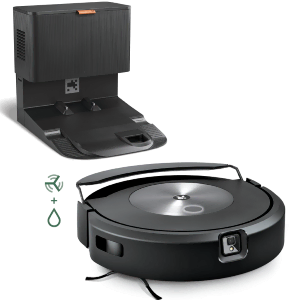In this comparison, we have the Roomba Combo J5 Plus and the Combo J7 Plus, versatile devices capable of vacuuming and mopping.
However, one exhibits notable limitations in its mopping functionality, along with differences in the ability to avoid carpets during mopping.
Starting with the primary differences:
| Roomba Combo J5+ | Roomba Combo J7+ |
|---|---|
 |  |
| Mopping: Yes (Separate Bin) | Mopping: Yes (Retractable Feature) |
| Avoids Carpets When Mopping: No (Have to set no-mop zones) | Avoids Carpets When Mopping: Yes |
| Automatic Dirt Disposal: Yes, No (When Mopping) | Automatic Dirt Disposal: Yes |
| Dirt Detection Tech: Yes, No (When Mopping) | Dirt Detection Tech: Yes |
| Weight: 7.49 lbs | Weight: 7.35 lbs |
| Bottomline: The Combo J5+ has a mop feature, but with that mopping add-on, its cleaning performance is limited, and it can’t auto-avoid carpets when mopping – which makes the Combo J7+ a better option. | |
| Check on Amazon | Check on Amazon |
Table Of Contents
- Roomba Combo J5 Plus Pros & Cons
- Roomba Combo J7 Plus Pros & Cons
- Table – Full Comparison
- J7+ is with Retractable Mopping
- Roomba Combo J5+ Doesn’t Avoid Carpets
- Dirt Detection & Automatic Dirt Disposal
- The Design
- 3-4 Stage vs. 4-Stage Cleaning System
- No Mop Zones
- Keep Out Zones
- Navigation + Mapping
- Auto Recharges, Auto Resumes
- HEPA Filtration
- iRobot App – Mopping Customizations in Combo J7+
- FAQs
- Conclusion
Roomba Combo J5 Plus Pros & Cons
- You can set your favorite cleaning routines through the app, a quick go-to clean every time.
- The equipped AI hazard detection tech makes the Roomba automatically avoid power cables, socks, pet feeding bowls, etc.
- No-mop zones feature.
- The Combo J5 Plus doesn’t detect and avoid carpets automatically. If a no-mop zone is not marked around, the robot will mop on the carpet, creating a mess.
- Even though Combo J5+ is a self-emptying model, when you use the mopping bin, it can’t self-empty.
Roomba Combo J7 Plus Pros & Cons
- The retractable mopping design enables the robot to automate carpet avoidance.
- The IoT factor in Combo J7 Plus is highly progressive, allowing control of every function, even precise tasks like zone-specific cleaning, through voice commands.
- The Combo J7 Plus weighs 7.35 lbs, lighter among feature-rich robotic models.
- The mopping pressure is not up to the mark for homes with frequent tough stains (i.e. tomato sauce splatters, ink, makeup stains).
Table – Full Comparison
| Product / Specification | Combo J5 Plus | Combo J7 Plus |
|---|---|---|
| Mopping Capability | Yes | Yes |
| Retractable Mop Feature | No | Yes |
| Carpets Avoid (Mopping Mode) | No | Yes |
| No Mop Zones | Yes | Yes |
| Dirt Detection | Yes | Yes |
| Dirt Detection (Mopping Mode) | No (Disabled) | Yes |
| Self-Cleaning | Yes | Yes |
| Self-Cleaning (Mopping Mode) | No (Disabled) | Yes |
| Height | 3.4 inches | 3.4 inches |
| Weight | 7.49 lbs | 7.35 lbs |
| Suction Power | 10 X (600 series) | 10 X (600 series) |
| Brush Rollers | Tangle-Free | Tangle-Free |
| Smart Mapping | Yes (Imprint) | Yes (Imprint) |
| Navigation Pattern | Rows | Rows |
| PrecisionVision Tech | Yes | Yes |
| Avoid Pet Waste | Yes | Yes |
| Keep Out Zones | Yes | Yes |
| Zone Cleaning | Yes | Yes |
| Auto Recharges | Yes | Yes |
| Auto Resumes | Yes | Yes |
| App + Voice Commands | Yes | Yes |
| HEPA Filtration | Yes | Yes |
J7+ is with Retractable Mopping
Both robotic vacuum mop combos can vacuum and mop at the same time. But, there is a significant difference here, which pushes Combo J7 Plus to the first position in this comparison if you are concerned about mopping a lot.
In Roomba J5+, you’ll get a separate mopping bin. It means – whenever you look for mopping floors, you remove the attached dirt bin and replace it with the mopping bin.
It’s like additional work, which doubts the objective of having a robotic cleaner, right? Yes. The term “robotic” means everyone expects no human involvement.
The Combo J7+ comes with a feature that addresses the J5 Plus limitation. It has a retractable mopping pad attached to it, which means you don’t have to move around to change bins; you can overlook the cleaning (vac+mop) process with Combo J7+, a pure robotic cleaner, we say.
What is retractable mopping?
To put it simply, we all know airplanes have retractable landing gear. They use it only when landing or taking off and go inside when flying. Similarly, Combo J7+ retracts its mopping pad to the top when not in use.
And when mopping, the Combo J7+ cleans with an applied pressure of 1.16 lbs (>0.5 Kg). Here, there is a wide margin for improvement. Applying pressure of 2 to 3 can be more beneficial, especially when handling tough stains like dried food spills or ink marks.
This retractable element is not with the lower-tier i-series and j-series combos.
Now, when you think of the budget point of view or some other part, you might feel it would be okay to change bins on the J5+. That is understandable. But there are two other downsides related to mopping functionality in J5 Plus.
Take a look at those, too, below.
Roomba Combo J5+ Doesn’t Avoid Carpets
The robotic vacuums usually don’t bypass carpets unless the carpet is thick. People don’t even consider robots to avoid them as carpets require routine vacuuming.
But what about mopping? It’s a different story. Mopping is not for carpets; they are damage-prone.
Speaking of the current combo vacuums, when you attach the mopping bin to the Roomba J5+, it will mop+vacuum the floors, and if a carpet is in the way, it will keep moving over the carpet – not ideal for carpets and robots either.
You have two options:
- Either take the carpets out before using the mopping bin (or)
- Set up “No-Mop Zones” (explained below) for all the carpeted areas so the robot skips them.
Both options aren’t hassle-free.
Here’s where the Roomba Combo J7 Plus advances. It’s sensor-system is more refined. Like J5+, it vacuums and mops in parallel, and, unlike J5+, when Combo J7+ detects a carpet, it automatically lifts the mopping pad, ascends onto it, and continues the vacuuming process.
It is the first issue with J5+ when mopping. Now, the second one:
Dirt Detection & Automatic Dirt Disposal
Let’s begin by talking about these features first.
The dirt detection technology is in both models. It enables the robot to work more attentively in areas with high dirt concentration.
Automatic self-emptying: The J5+ and J7+ come with charge cum disposal bases. When the bins get full, the robots return to the bases and empty them.
In Combo J5 Plus, when you set the mopping bin, the above two features will be disabled. Though it is called a simultaneous mop+vac cleaner, it is not convincing like Roomba Combo J7+.
The Design
Both robots look pleasant, but the Combo J5+ design isn’t unique, similar to the older Roomba i-series models. The Combo J7+, on the other hand, stands out, all due to its retractable mopping design.
What’s surprising is that even though the Combo J7+ has this extra retractable mopping feature, it’s a tad lighter than the Roomba J5+. The J5+ weighs 7.49 lbs, while the Combo J7+ is only 7.35 lbs.
Keeping weight aside, the height of robot vacuums holds great significance. With shorter height, it would be easier for robots to travel under couches, beds, kitchen cabinets, and TV stands, as these have limited space underneath.
In this regard, both the Combo models are identical, measuring 3.4 inches at scale.
Note: The mopping bins with the Roomba Combo J5+ and the Combo J7+ are one-piece but with two separate chambers. One holds the water and cleaning solution, while the other is the usual dirt bin. This design ensures that the cleaning liquid and the dirt won’t mix.
3-4 Stage vs. 4-Stage Cleaning System
Would you like to know about these stages? And is there any difference between Combo J5+ and Combo J7+ in the cleaning system factor?
Let’s break it down:
Both Roomba models have an edge-sweeping brush on the side that spins continuously and pulls the dirt in the robot’s path (robot’s width). The robots have two tangle-free rubber brush rollers that loosen the floor’s dust. Then, in the third stage, the robust suction (ten times more robust than the 600-series) draws the dirt inside. These are the first three stages, same with both.
Note: The side brush pulls dirt into the robot’s path for vacuuming. If some debris is a bit away from the spinning brush, the robot will vacuum it on its subsequent pass in the next row. Roomba J5+ and J7+ robots move in rows to provide complete coverage.
The fourth stage is mopping.
In the Combo J7+, as the mop is affixed to the robot, it always goes through all four stages.
With the Roomba J5+, it has 3-stage in general. To get to that fourth, you have to swap out the dirt bin for the mop bin.
No Mop Zones
Setting no-mop zones is a shared feature in both models: you can instruct the Roombas not to mop in precise areas.
After listening to this, you might assume this function is not helpful, but it is. Particularly more beneficial with the Roomba J5 Plus.
Since the Roomba Combo J5 Plus doesn’t auto-detect and avoid carpets during cleaning, you can use the “no mop zones” feature to mark around rugs and carpets – it restricts mopping the carpets.
What about the Roomba Combo J7+? It automatically detects and avoids carpets. How no-mop zones is worth here?
Carpets are not the only situations. Numerous situations would arise sometimes.
Imagine you have a small section in the dining area where the hardwood floor is slightly worn out and sensitive to moisture. In that case, open the app and set no mop-zone. The Roomba J7+ would not mop there, preventing further damage.
Keep Out Zones
In addition to the above-described “no mop” feature, there is another option – “keep out zones.”
It serves a similar purpose. With this feature, you can assign areas where you don’t want the Roombas to vacuum, like around delicate flower vases, etc.
As these models are near the top-ends, they detect need-to-away objects, like power cords, and avoid them based on hazard detection mechanisms.
However, it’s better to set the “keep out zones” because even with sophisticated technologies armed, a robotic device may not detect all the obstacles an individual would expect them to avoid while cleaning.
Contrarily, you can instruct these J-series models to clean certain zones or rooms – zone-cleaning and targeted room cleaning.
Both of these features prove priceless in various day-to-day scenarios.
Once you assign the zone or label the room – you can voice command the robot to clean that respective (Example: Roomba, Go Clean The Play Zone, Go Clean The Kitchen).
Navigation + Mapping
On Roomba’s initial run, these models create a map of your home and ask for basic information about obstacles, like whether to avoid them or clean around them. The J-series models map your home seven times faster than the i-series.
Adding to that, these Combo models, Roomba J5 Plus and J7 Plus, have PrecisionVision navigation, not seen in mid-range i-series combo models.
This PrecisionVision navigation lets the robots avoid obstacles that seem doubtful and ask you for your order and follow that from the next pass. And general things like power cords, litter boxes, and pet waste are avoided without causing any issues.
We have seen how an i-series performed when cleaning around the cables and were disappointed with it.
It either attempts to ascend the cable or pulls it along, unsafe actions. Combo J7 Plus and Combo J5 Plus would not do that.
Auto Recharges, Auto Resumes
These Roomba combos will travel to their charging stations to recharge when a low battery is detected midway. When enough charge is restored, the robots will automatically travel back to the exact spot where they had left off and continue cleaning.
HEPA Filtration
An identical HEPA-type filter is featured in these Roomba Combo Models. Allergens and dust in your residence are screened and entrapped by the filter.
iRobot App – Mopping Customizations in Combo J7+
You can launch the same app for both – the iRobot HOME app. At your convenience, you can set up cleaning schedules, monitor the robots, target specific rooms, and even view the statuses of the filters using the iRobot app.
One of the factors we deeply value about iRobot is the depth of cleaning customization it provides. You can tailor cleaning preferences for each room and even for specific zones, giving top-notch cleaning control.
Let’s say – you prefer the Roomba Combo J7+ to vacuum and not mop in the laundry room. You choose that through the app. Once set, when the Combo J7 Plus enters the room, it automatically retracts its mopping pad.
Additionally, preferences, such as adjusting the amount of liquid released during mopping and the number of cleaning passes, are open for both the Combo models.
FAQs
Does the self-disposal bin auto-refill the cleaning solution?
No. This feature is not in both the J5+ and J7+ Combos. You need to watch the robot’s path and check if the floor isn’t getting sufficient wetness. It may seem like a hurdle initially, but once you know how much cleaning solution the robot uses and how often you need to refill it, you can plan accordingly. Unless you have a large house above 4,000 – 5,000 sq. ft, you won’t need to think of refilling it.
Does the Combo J7 Plus detect all types of carpets, from low-pile to thick?
Yes. The Dry Rug Intelligence technology in Combo J7 Plus detects all types of carpets irrespective of thickness.
Are the mopping pads the same in J5 Plus and J7 Plus Combos?
No. The design is different. One is not compatible with the other. The cleaning pad in the Roomba J7+ Combo seems thicker and lasts longer. Both are washable.
Conclusion
If you’re seeking a robotic device that handles vacuuming and mopping seamlessly, the Combo J7 Plus is undoubtedly the best choice.
After swapping the dirt bin with the mopping bin in the Roomba Combo J5+, the auto-emptying function would be disabled. Unless you use the mopping pad sparingly, you won’t fully benefit from the self-emptying feature, making this a possible waste of finances on the J5 “plus” aspect.
Regarding the drawback of auto-carpet detection and avoidance in the Combo J5 Plus, it’s worth noting that the no-mop zones feature could help manage this issue to some extent.
Recent Updates:
- Sept 28, 2023: Formatted & Published By
Sam Y - Sept 27, 2023: Reviewed & Written By
Lingeshakumar

